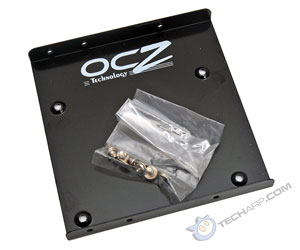The Connectors
 |
This is a Serial ATA drive, with native support for SATA 3.0 Gb/s. It is backward-compatible so you will have no problem using it with older SATA 1.5 Gb/s controllers. However, the faster SATA 3.0 Gb/s interface is necessary for optimal performance since this OCZ SSD boasts a maximum internal (NAND-to-buffer) read transfer rate of 285 MB/s.
Like all Serial ATA drives, it comes the standard SATA data (left) and power (right) connectors and is hot-pluggable. That means you can connect and disconnect this solid state drive to your PC while it's still running. There is no jumper block because there's really nothing for you to set.
3.5" Drive Bay Adaptor
The OCZ Vertex 2 comes with a simple 3.5" drive bay adaptor, which is basically a piece of folded sheet steel painted black. It allows you to install the Vertex 2 solid state drive in a desktop. There are four screw points for you to attach the Vertex 2 (or any other 2.5" drive).
 |
 |
The second picture shows the Vertex 2 solid state drive properly secured to the 3.5" drive bay adaptor. Once you attach the drive to the adaptor, just slide the entire assembly into any 3.5" drive bay and secure it with screws.
SSD Maintenance
First of all, you should never, ever defragment solid state drives using the usual hard disk drive defragmentation software. Spatial fragmentation of data has no effect on SSD performance - fragmented bits of data are accessed just as quickly as nicely packed blocks, so it is pointless to "defragment" the data blocks in the traditional sense. Doing so will also reduce the flash memory cells' lifespan by putting them under additional wear. Remember - MLC flash memory will only last about 10,000 erase/write cycles.
Unlike hard disk drives, flash-based SSDs write and overwrite data in large blocks of 512 KB to 1 MB in size. Even if you only need to overwrite one byte of data, it has to erase and overwrite an entire block. This causes a lot of wear on the memory cells and greatly reduces their lifespan. To prevent that from happening, SSDs perform wear leveling by spreading the writes so that the flash memory cells have equal wear.
To further improve lifespan and performance, SSDs also use a write buffer to temporarily store and combine writes before they are actually written to the flash memory. This reduces the number of block erases required and increases the memory cells' lifespan. Western Digital did not reveal how large the Vertex 2's write buffer is but it most certainly has a write buffer. As helpful as wear leveling and the write combine buffer are, they cannot address the issue of "dirty" blocks, which will develop over time.
Most operating systems will not directly inform the SSD which data blocks have been deleted. They will merely flag the deleted data blocks in their file system so they can be overwritten by new data. Unlike the magnetic media in hard disk drives though, the NAND flash memory cells in solid state drives can only be written to if they are empty. Cells that contain data (even useless, deleted data) must be erased before any new data can be written to it. This requires the SSD to perform the time-consuming read-erase-modify-write cycle to overwrite the "dirty" block, which not only cripples performance but also increases wear on the affected memory cells.
To counter this, newer SSDs like the OCZ Vertex 2 support the TRIM command, otherwise known as the ATA8-ACS-2 DATA SET MANAGEMENT command. Operating systems that support TRIM (e.g. Microsoft Windows 7) will notify the solid state drive when data blocks are deleted in the file system. This allows the solid state drive to perform garbage collection in the background - internally erase the affected blocks so that they are ready to be written to.
Currently, Microsoft Windows 7, Windows Server 2008 R2, Linux 2.6.33, FreeBSD 8.2 and Mac OS X Snow Leopard support TRIM. If you are using one of these operating systems, then you have nothing to worry about. The TRIM command will help your solid state drive clean up those "dirty" blocks for optimal performance.
However, if you are using an older operating system, you can use special utilities to perform manual garbage collection. Some SSD manufacturers, like Intel, will provide you with such a utility although you can opt for third-party utilities or even newer defragmentation software that support solid state drives. Basically, these utilities will retrieve the list of free blocks from the file system and pass it to the SSD in the form of TRIM commands so that it knows which blocks to erase internally.
Sadly, OCZ does not provide such a software, but if you are serious about SSD performance, you should definitely use Microsoft Windows 7. It not only supports TRIM (which solves your garbage collection problems), it is also the first Microsoft Windows operating system to be optimized for SSDs.
Support Tech ARP!
If you like our work, you can help support out work by visiting our sponsors, participate in the Tech ARP Forums, or even donate to our fund. Any help you can render is greatly appreciated!
Page |
Topic |
|
1 |
||
2 |
||
3 |
• The Vertex 2 (E) 120 GB SSD |
|
4 |
||
5 |
||
6 |
||
7 |
||
8 |
||
9 |
||
10 |
||
11 |
||
12 |
<<< The OCZ Vertex 2 (E) 120 GB Solid State Drive, Usable Capacity, Specifications : Previous Page | Next Page : Testing The OCZ Vertex 2 >>>







 Add to Reddit
Add to Reddit
